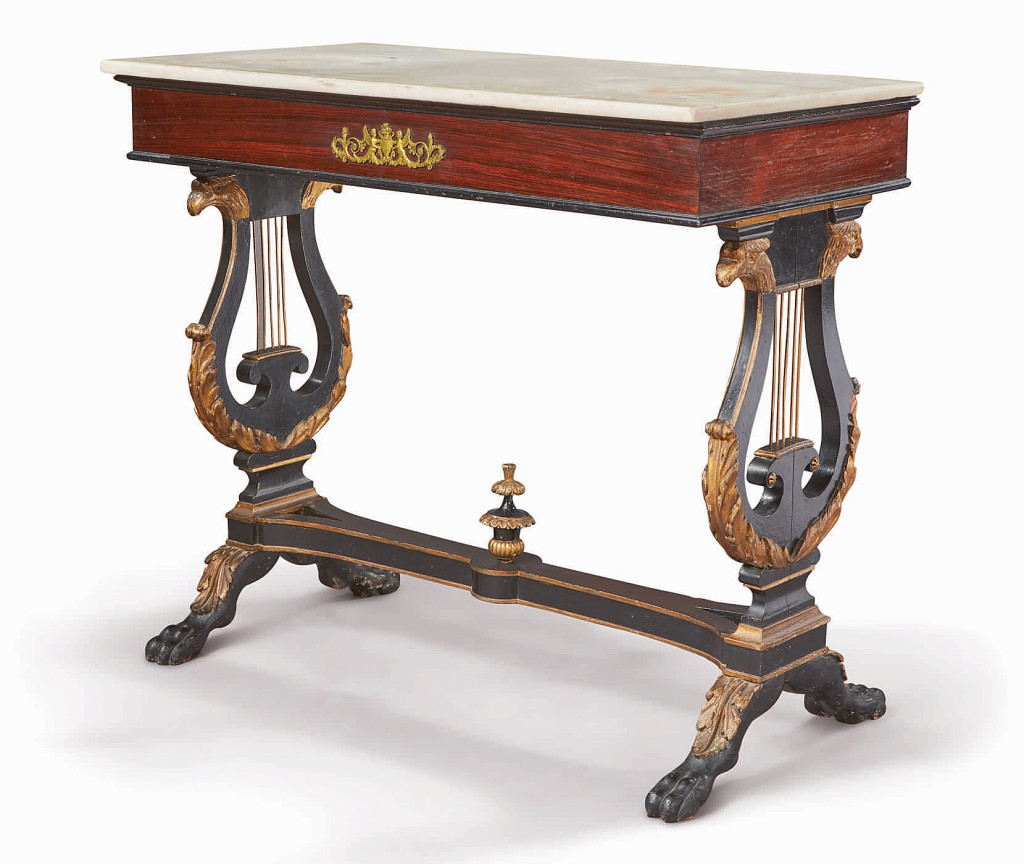
Topping the week was this important classical ormolu-mounted, parcel-gilt, rosewood, ebonized wood and marble top pier table by Charles-Honoré Lannuier (1779-1819), New York, circa 1808-12. It left its high $50,000 estimate far behind when it sold for $403,200. — Important Americana Furniture and Folk Art
Review by W.A. Demers, Photos Courtesy Sotheby’s
NEW YORK CITY – Sotheby’s Americana Week sales in 2021 carried on the tradition of presenting notable works from important American private collections and institutions. Choice furniture, decorative arts, folk art, silver, Chinese export ceramics, prints, historic maps, books and manuscripts formed the parade of online sales that were conducted beginning on January 8 and ending on January 22. The combined result over the three marquee auctions totaled $3,766,306.
An important classical ormolu-mounted, parcel gilt, rosewood, ebonized wood and marble top pier table by Charles-Honoré Lannuier (1779-1819), New York, circa 1808-12, left its high $50,000 estimate far behind when it sold for $403,200 on January 21. It was the top lot in the Important Americana Furniture and Folk Art session but also the highest selling lot in the firm’s trio of Americana Week sales. Labeled and stamped by the famous French émigré New York cabinetmaker, the pier table is a new discovery of his work and had never been published or offered for sale on the marketplace until this time. With its acanthus-carved lyre supports capped with eagles’ head terminals, it represents a previously unknown pier table form made by Lannuier. In keeping with his practice, it is made of the finest quality rosewood with elaborate, classically inspired supports, an elegant ormolu mount and heavy lion’s-paw feet. It survives with its original white Carrara marble top, which Lannuier had shipped at high cost from Italy. The sale totaled $2,314,368 and was 71.5 percent sold.
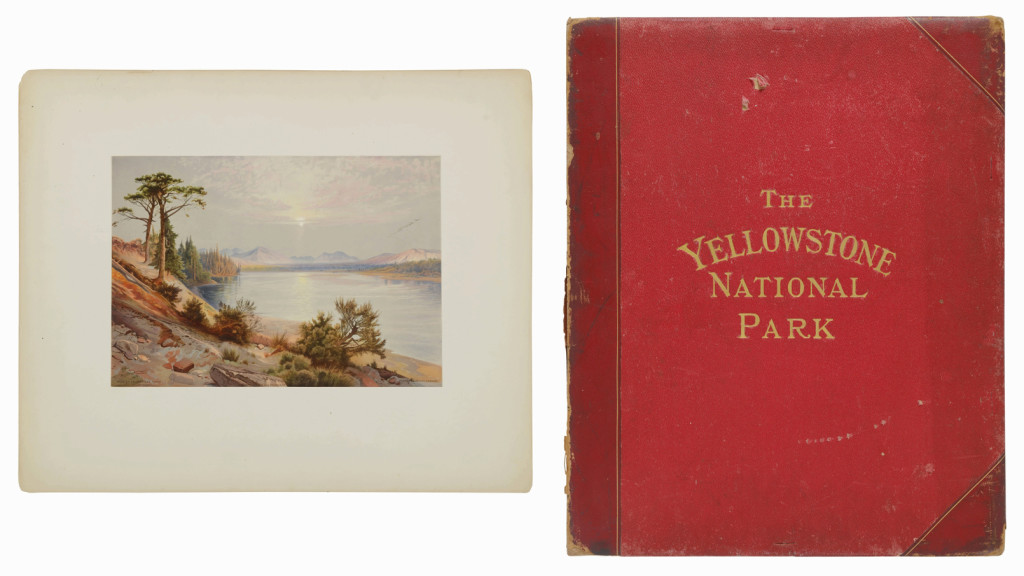
Ferdinand V. Hayden, The Yellowstone National Park, 1876, was a rare complete set and finished at $277,200, above its $180,000 high estimate. — Important Americana Furniture and Folk Art
In addition to the Lannuier table, the sale featured unique pieces from a wide range of important collectors, including Margaret P. Gregory and a founding family from Connecticut. Highlights included an assortment of historical weathervanes, American paintings, and a selection of Connecticut, Pennsylvania and New York furniture.
The sale offered what has been characterized as “The greatest American landscape book of the post-Civil War era.” The Yellowstone National Park and the mountain regions of portions of Idaho, Nevada, Colorado and Utah were depicted by Thomas Moran and published in Boston by L. Prang and Company in 1876. Ferdinand V. Hayden headed the US Geological Survey during the period it was investigating the mountain regions of the West. Moran accompanied the Hayden expedition to Yellowstone in 1871, making many drawings on location. The 15 watercolors reproduced by Prang were among the earliest pictorial records of the spectacular landscapes of the then-unexplored region, and they remain among the best representations of what became the country’s first national park.
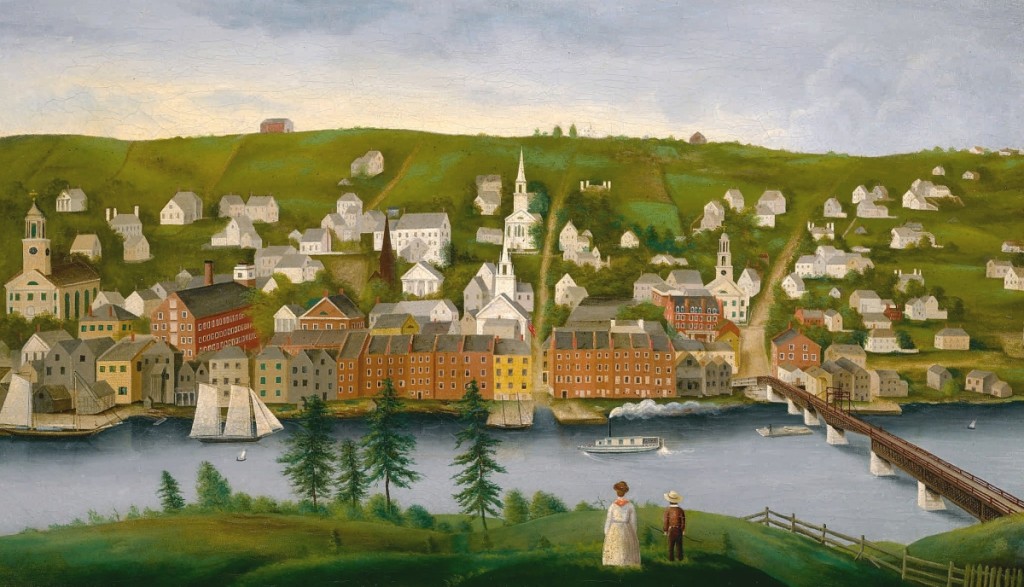
From the estate of Margaret P. Gregory came an American School, Nineteenth Century oil on canvas view of Hallowell, Maine, circa 1860, that was bid to $201,600. — Important Americana Furniture and Folk Art
The reproductions of the paintings are extraordinary productions in their own right, using as many as 56 layers from color lithographic stones to recreate the depth and grandeur of the American West. Complete sets are uncommon on the market, and the set finished at $277,200, above its $180,000 high estimate.
There was a diverse selection of folk art on offer – variety of weathervanes, portraits and nautical paintings.
From the estate of Margaret P. Gregory came an American School, Nineteenth Century view of Hallowell, Maine, that was bid to $201,600. The circa 1860 oil canvas, 20¾ by 35½ inches, depicts a mother and her son gazing upon the bustling waterfront and business district of the key trade corridor to interior Maine from the Atlantic coast. Hallowell’s locale along the Kennebec River contributed to its stature as a major hub of maritime commerce, shipbuilding and manufacturing.
Another oil on canvas, depicting the New River near Salem, Va., capturing the William Snidow Farm earned $60,480, five times its high estimate. From a hilltop vantage point, German artist Edward Beyer captured the verdant landscape of William Snidow’s farm, the meandering New River and the Blue Ridge Mountains towering in the distance. Beyer painted the 20-by-29½-inch work during the three years he sojourned in Virginia. From 1854 to 1857, he traversed the state as an itinerant artist sketching the scenic landscape, bustling towns and stately county estates with a near photographic precision informed by his classical training at the Dusseldorf Academy.
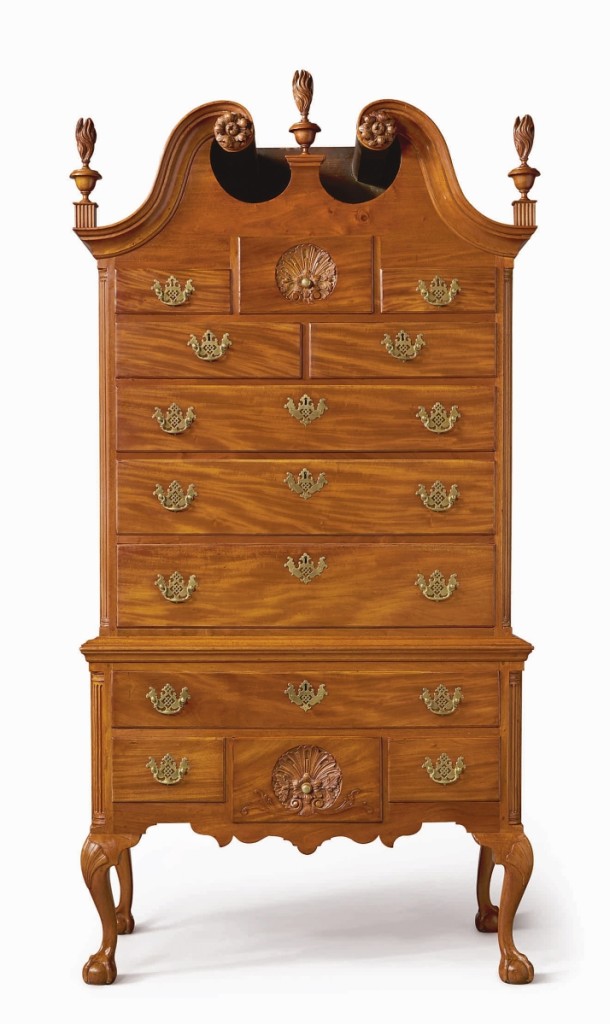
A Chippendale carved and figured mahogany bonnet-top high chest of drawers, circa 1760, case attributed to William Wayne (w. 1756-1786); carving attributed to Nicholas Bernard and Martin Jugiez, Philadelphia, topped its $80,000 high estimate to settle at $107,100. — Important Americana Furniture and Folk Art
One of the twin brothers Bard, who were prolific marine artists in the mid-Nineteenth Century, James Bard (1815-1897) in 1868 painted a portrait of the steamboat Florence, which ran in New York waters for a few years until taken to Washington, DC. His 28¼-by-48½-inch painting sailed to a within estimate $44,100, propelled by Bard’s mariner’s eye and detailed draftsmanship. It was signed “J. Bard. Painter. NY,” lower right, and inscribed Florence on ship and flag.
As far as furniture goes, the name Chippendale was prominent among the sale’s leading highlights. To begin was a Chippendale carved and figured mahogany bonnet-top high chest of drawers, circa 1760, case attributed to William Wayne (w. 1756-1786); carving attributed to Nicholas Bernard and Martin Jugiez, Philadelphia. With provenance to Yardley, Penn., dealer C.L. Prickett, it topped its $80,000 high estimate to settle at $107,100.
From circa 1770, a rare Chippendale carved mahogany piecrust tilt-top candlestand, Philadelphia, said to be one of the rarest surviving colonial furniture forms, earned $75,600. Appearing to retain its original wooden lock ring and key as well as an early historic surface, it measured 25-1/8 inches high by 17-3/8 inches wide by 17-1/8 inches deep.
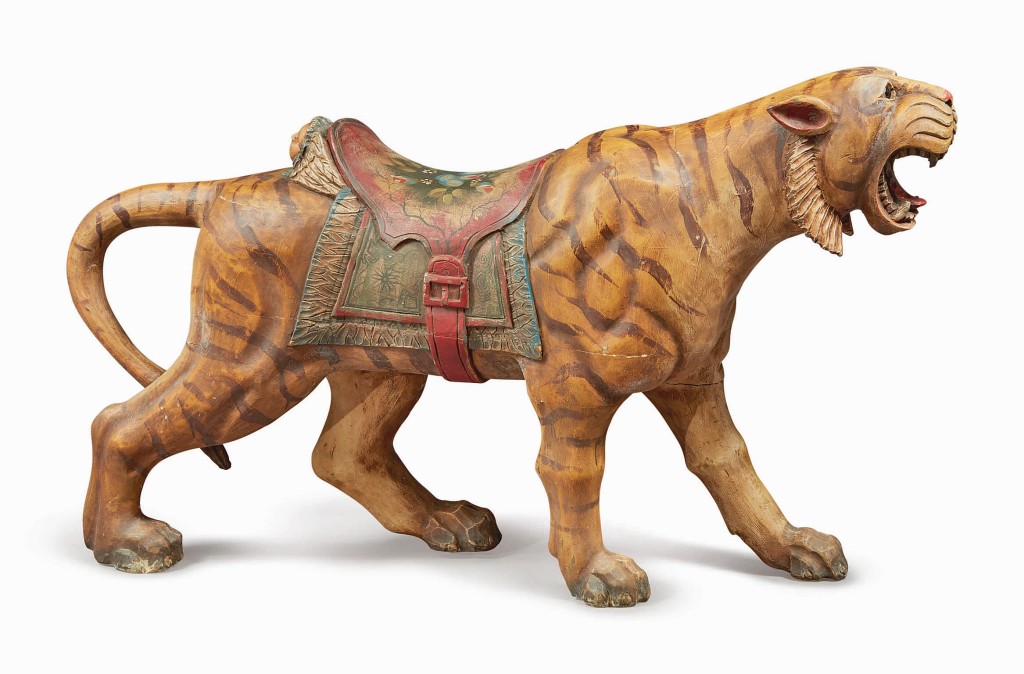
A carved and paint-decorated pine carousel tiger was made by the Philadelphia Toboggan Company. The auction house dated it to circa 1905, a year after the company’s founding. The Philadelphia Toboggan Company would produce 94 carousels in its 30 year tenure, though it only made six tigers. This example sold for $37,800.
And fetching $40,320 was the Schuyler family rare Chippendale carved and figured mahogany turret-top card table, New York, circa 1760. With a fitted top and dimensions of 29 by 34½ by 17 inches, catalog notes observed that a closely related card table is illustrated in Morrison Hecksher, American Furniture in the Metropolitan Museum of Art, Volume II.
As a coda to the sale’s top ten, a molded copper “Goddess of Liberty” weathervane, attributed to William Henis or Vincent W. Baldwin, Philadelphia or New York, circa 1875-79, went out at $44,100. Offered with no reserve, proceeds of the vane’s sale benefit a new folk art initiative at the Museum of Fine Arts, Boston. It had originally been erected between 1877 and 1879 on the Hale family homestead in Tyringham, Mass., a small town in the Berkshires, and had descended in the family until consigned to a Christie’s New York sale in January 2006 and purchased by Boston dealer Stephen Score.
Silver, Chinese Export and Prints
As in past years, Sotheby’s chose January to present a group of silver, Chinese export art and American prints in a sale that ran January 8-22. The sale totaled $1,141,938 and was 75.5 percent sold by lot.
Chinese export art included iconic designs and forms, such as a pair of elephant tureens and a rare goose tureen, as well as other rare figures. Other highlights included a Yongzheng period famille rose “figure” fishbowl and other European subject and armorial porcelains.
Topping the sale was a rare pair of Chinese export elephant-form tureens, covers and stands, Qing dynasty, Qianlong period, circa 1770. From a Midwestern collection, each tureen was delicately modeled as a recumbent elephant with the head turned to one side tucked snugly into the body with the trunk coiled. The cover of each was surmounted by a finial in the form of a European man wearing a long purple coat and tricorn hat, kneeling atop a purple-edged iron-red saddle. The lobed oval stand was painted in the center with a similarly dressed European holding a whip sitting astride a recumbent elephant in landscape within an iron-red and gilt border. Each measuring 6-3/8 inches long, the pair sold for $176,400, nearly twice the high estimate.
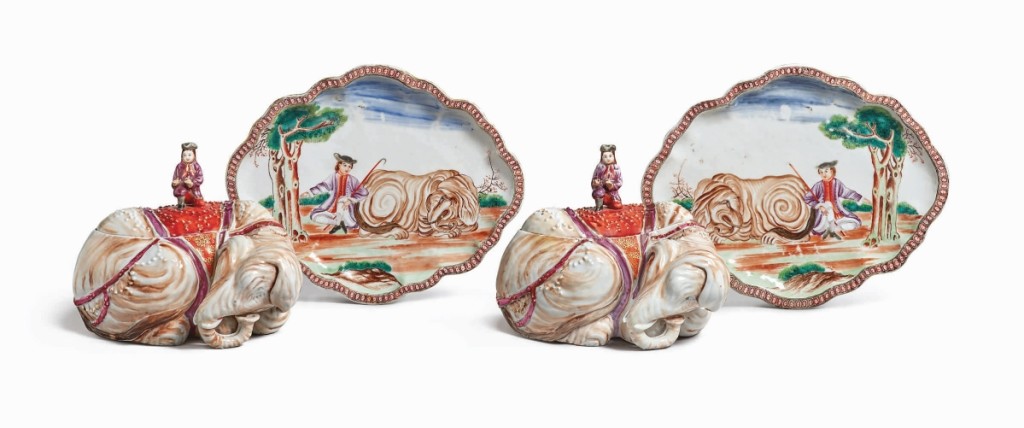
Topping Sotheby’s sale of silver, Chinese export and prints was this rare pair of Chinese export elephant-form tureens, covers and stands, Qing dynasty, Qianlong period, circa 1770. From a Midwestern collection, the pair sold for $176,400, nearly twice the high estimate.
Finishing at $107,100 and from the same Midwestern collection was a rare Chinese Export goose-form tureen and cover, Qing dynasty, Qianlong period, circa 1770. A total of 16 inches high, naturalistically and boldly modeled, the goose raises its head supported by a long curving neck, its body finely enameled with sepia plumage and its wings molded with overlapping feathers in green, turquoise, iron-red and sepia with details picked out in gilding, the webbed feet tucked under the body. Maybe the term “lucky goose” stems from the fact that goose tureens are one of the most impressive forms in Chinese export art made for the West. A symbol of power and status in a European interior in the Eighteenth Century, the presence of a Chinese export goose tureen conveyed not only the exquisite taste of the owner, but also the wealth of the family.
A rare and large Chinese Export famille rose “Figures” fishbowl, Qing dynasty, Yongzheng period, nearly doubled its high estimate to bring $47,880. Catalog notes point out that while Chinese export fishbowls are most often seen with bucolic scenes depicting birds and blossoming flowers, ones that depict figural subjects are extremely rare. In this one, female figures are shown in a chamber with another lady being pursued by a military official. The reverse shows scholars reading and figures tending to a horse, and the bowl’s interior is decorated with swimming fish and water plants.
The pomegranate is prized in Chinese iconography, symbolizing fertility due to its numerous seeds. Another rare pair of Chinese export tureens, covers and stands, a “Tobacco Leaf” pattern in pomegranate-form tureens, Qing dynasty, Qianlong period, circa 1785, provided fertile ground for bids, achieving $44,100, more than triple expectations.
The silver collection in the sale included later examples by Tiffany and Gorham alongside earlier pieces by Paul Revere, Elias Pelletreau, Joseph Richardson, Samuel Casey and African American/Caribbean silversmith Peter Bentzon.
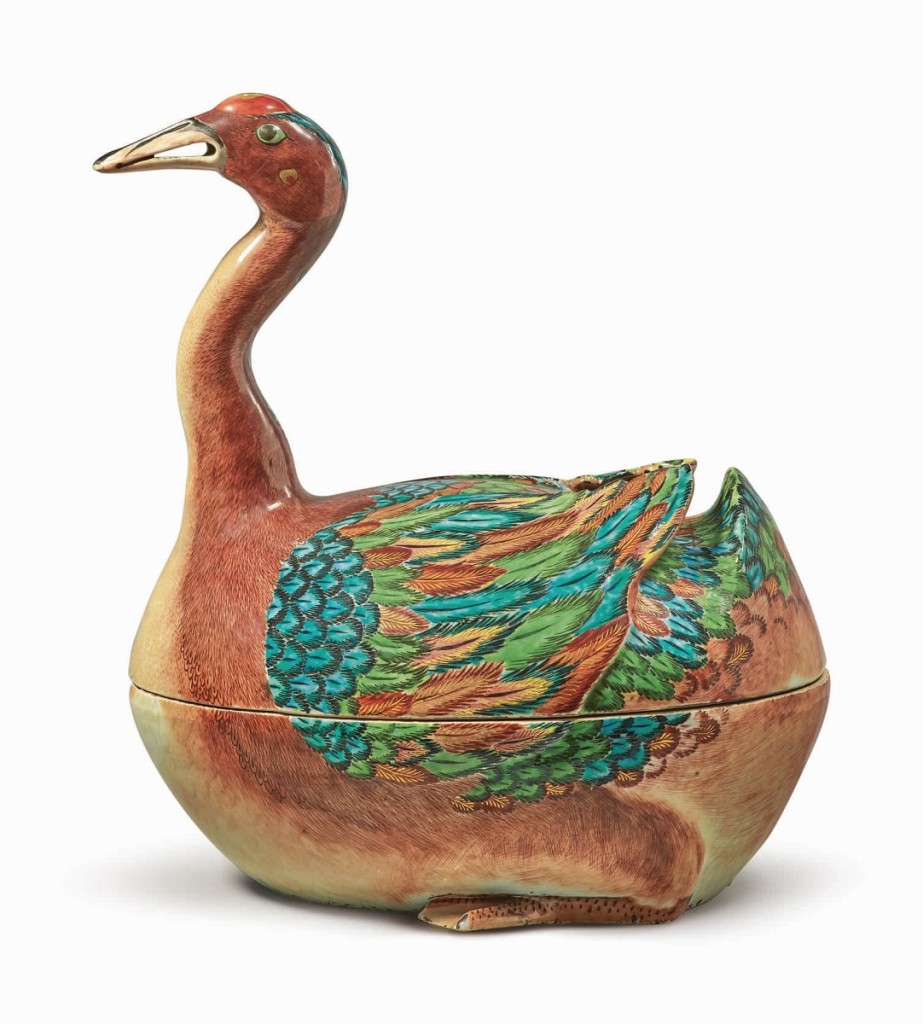
Finishing at $107,100 at 16 inches high was a rare Chinese export goose-form tureen and cover, Qing dynasty, Qianlong period, circa 1770. — Silver, Chinese Export and Prints
Among the wide scope of important silver were Colonial-era pieces ranging from as early as an American small Johannis Nys tankard from 1716, Philadelphia, which doubled its high estimate to finish at $30,240 to a nutmeg grater by Peter Bentzon, a free man of color from St Croix and Philadelphia, which adds a tenth work to his previously nine known pieces. It changed hands at $40,320.
Modern gold was represented by a 14K gold Santa Anita Handicap horse race trophy by Shreve & Co., San Francisco, dated 1968, won by “Mr Right.” A plain two-handled cup with gadrooned base, engraved on one side with arms and “Santa Anita Handicap,” it was bid to $50,400.
There was also a selection of Americana prints offered, largely consisting of animal-themed works inspired by John James Audubon (1785-1851), the late American ornithologist and painter who revolutionized the print industry with his distinctive portrayal of different species of birds in the early Nineteenth Century. Notable among prints crossing the block was the “Carolina Parrot” print featuring seven colorful and lively parrots, which sold for $100,800 and Audubon’s (after) “American Pelican” (Plate CCCXI), which went out at $88,200.
Vineyard Dreams
Totaling $310,717 with a 96.5 percent sell-through rate was the third sale in the Americana Week series, Vineyard Dreams: Property from a Martha’s Vineyard Collection. It was a nautically inspired collection offering a diverse array of works ranging from a very group of folk art paintings, a selection of Pennsylvania furniture, weathervanes and decorative objects.
Belle of the ball was Cornelia Eliza Morse, who stood stoically with Bible in hand for her American School portraitist. The oil on panel, circa 1830, 46 by 18¼ inches, brought nearly three times its high estimate at $88,200. According to catalog notes, Cornelia Eliza Morse was born on January 1, 1820, in Eaton, N.Y. She married John Howard Raymond in 1840 and the couple had three daughters and two sons. During their marriage, John served as the first president of the Polytechnic Institute of New York University and the second president of Vassar College. He was regarded as a moral and intellectual guiding light who played a pivotal role in the early founding of these institutions. Cornelia passed away on February 1, 1905, in Brooklyn. The portrait had passed down through the family and had most recently abided with Olde Hope Antiques.
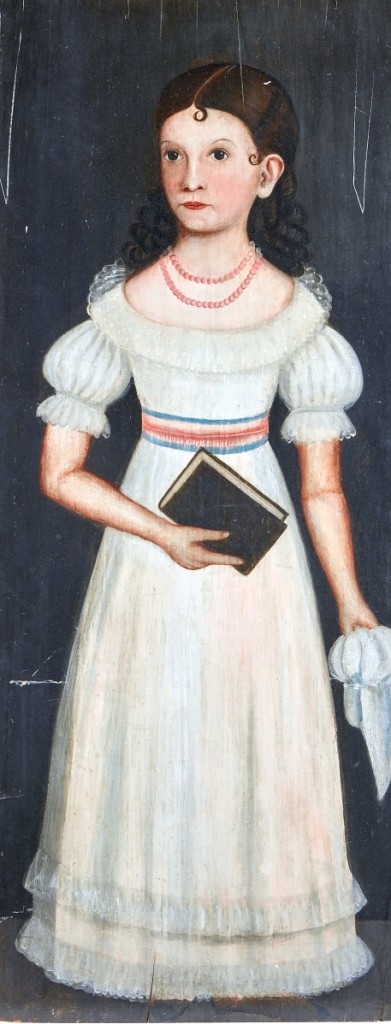
“Cornelia Eliza Morse,” an American School portrait in oil on panel, circa 1830, 46 by 18¼ inches, brought nearly three times its high estimate at $88,200. — Vineyard Dreams
Another folk art highlight was a portrait of a lady by Micah Williams (1782-1837), a pastel on paper, 19½ by 24½ inches, that reached $6,930.
A group of 12 shell watercolors by an unknown artist found favor with bidders who took them from a $2/3,000 estimate to $21,420. Watercolor and gouache on paper and done around 1880, each was 13¾ by 10¼ inches, the set having provenance to W. Graham Arader III, New York.
Representing Pennsylvania furniture and fetching $18,900 was a Federal polychrome paint-decorated poplar blanket chest with two drawers, Lancaster County, circa 1780. Inscribed Barbara Langewecker, it retained its original brass and iron hardware, measured 27½ by 51 by 24 inches and had provenance to Olde Hope Antiques.
From Connecticut, a Federal paint-decorated pine tall case clock, 84 inches high, with works by Riley Whiting, Winchester, Conn., circa 1813, gaveled at $8,190. It featured a wooden 30-hour weight-driven movement with strike, open-worked hands, grain painted in shades of light and dark brown with green decoration on hood and door, white-painted dial with gilt and colored eagle at the top and decorated elements at each corner.

Striking $8,190 was this Federal paint-decorated pine tall case clock, 84 inches high, with wooden works signed by Riley Whiting, Winchester, Conn., circa 1813. — Vineyard Dreams
Highlights also included an offering of weathervanes, such as American sheet copper and zinc gaff rigged sloop weathervane from the Twentieth Century selling for $17,640; an American sheet metal banner weathervane from the Nineteenth Century taking $10,710; and a molded copper “Black Hawk” horse weathervane attributed to Harris and Company, Boston, circa 1890, that brought $7,560.
Notable decoratives included two shellwork sailor’s valentines, probably Barbados, circa 1880, taking a $7,560 bid and also going out at $7,560, an American figural hooked rug with a design attributed to James and Mercedes Hutchinson, New York, circa 1930. The wool and cotton on burlap was inscribed “Shed No Tears For A Sailor’s Bride Her Life Is N’er Monotonous One Day He’s Bidding Fond Adieu The Next He’s Coming Back To You From London Philadelphia Singapore Or Some Other Gay Metropolis.”
Prices given include the buyer’s premium as stated by the auction house. For more information, 212-606-7000 or www.sothebys.com.












_american_pelican.jpg)

_carolina_parrot_.jpg)



















